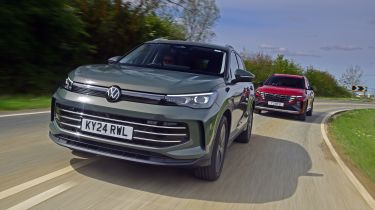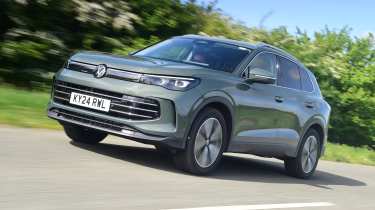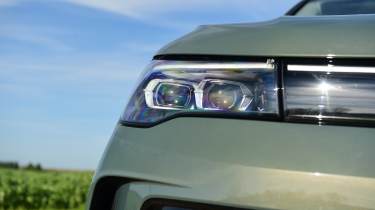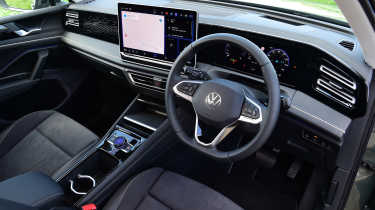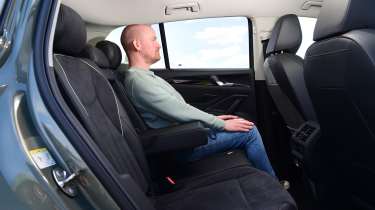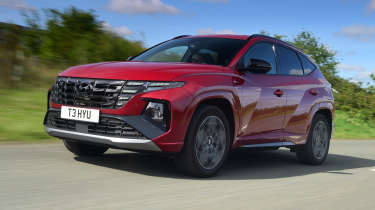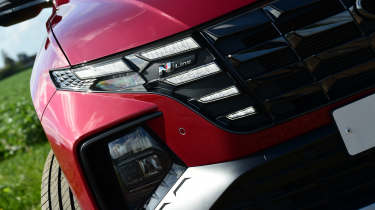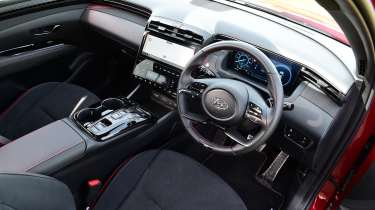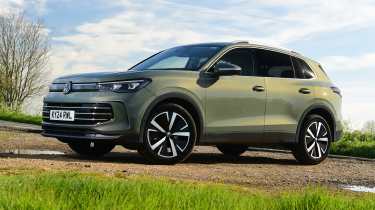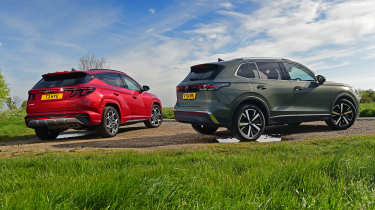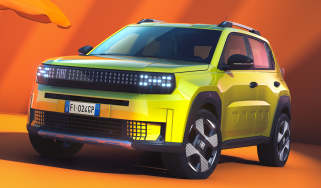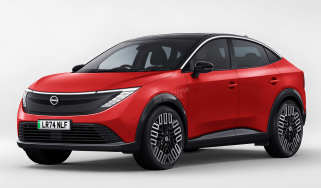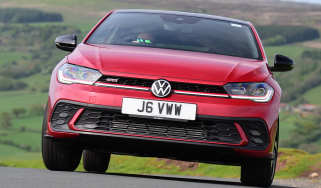Volkswagen Tiguan vs Hyundai Tucson 2024 twin test: family SUVs fight it out
The new Volkswagen Tiguan takes on the Hyundai Tucson for compact family-SUV honours
Car buyers love to feel like they’re treating themselves. Given the choice of two cars with similar price and ability, you can’t blame someone for steering towards the one that feels like the slightly posher, more desirable alternative.
This aspirational goal is something that Volkswagen has tapped into brilliantly for decades, by giving its range of family cars a premium feel that does just enough to elevate the marque above most alternatives.
However, things haven’t been quite so straightforward in recent years, and other rivals have cracked that same formula. Now VW wants to re-establish its lead in the family SUV class with the third-generation Tiguan.
One of the toughest challengers in a class bursting at the seams with strong competition is the Hyundai Tucson. Its place
at the top is deserved; not only does it tick all of the family car boxes, but it also manages to sprinkle a dusting of the premium appeal that has been a key VW selling point for so long.
So does the latest Volkswagen Tiguan have the talent to overcome our current class favourite, or has Hyundai beaten VW at its own game?
| Volkswagen Tiguan 1.5 eTSI DSG Elegance | Hyundai Tucson 1.6T Hybrid N Line | |
| Price: | £39,290 | £38,385 |
| Powertrain: | 1.5-litre 4cyl turbo mHEV, 148bhp, front-wheel drive | 1.6-litre 4cyl turbo HEV, 226bhp, front-wheel drive |
| 0-62mph: | 9.1 seconds | 8.0 seconds |
| Test efficiency: | 38.1mpg/8.4mpl | 39.9mpg/8.8mpl |
| CO2: | 149g/km | 131g/km |
| Annual VED: | £180 | £180 |
Volkswagen Tiguan
Volkswagen has sold more than 7.6 million Tiguans since the first generation was launched in 2007, making it one of the firm’s most popular cars. This Mk3 model will target similar success, with a range starting from £34,075. Our test car comes in high-ranking Elegance trim, which costs £39,290 before options.
Tech highlights
While the Tiguan looks different from its predecessor – it ditches the Mk2’s sharp creases and sporty touches for a softer appearance – under the skin it’s riding on a heavily revised version of the same MQB platform. The updates allow the newcomer to take VW’s latest PHEV powertrains; a large 19.7kWh battery enables a WLTP range of up to 62 miles, while a 148bhp electric motor promises class-leading performance in EV mode.
The car we’re testing here has a more familiar powertrain. The 1.5-litre TSI petrol saw service in the last Tiguan, but it has gained mild-hybrid tech to improve fuel efficiency. This 48-volt system provides an 18bhp electric boost to take load off the combustion engine, and enables engine-off coasting and quicker stop-start tech in traffic. In total the system produces 148bhp and 250Nm of torque.
The latest Tiguan has also grown, but only very slightly; it’s 53mm longer, 28mm taller and 3mm wider than the old car. Adaptive dampers are an optional extra not fitted to our test car.
Safety: Euro NCAP hasn’t tested the Tiguan yet, but thanks to the inclusion of the brand’s Vehicle Dynamics Manager for the first time, it should be more predictable in emergency situations than ever before. This system integrates the electronic differential locks, stability program and (when fitted) adaptive dampers, braking individual wheels and changing damping rates on the fly.
On the road
The Tiguan manages to behave just as you’d expect a VW to feel – not exactly exciting, but competent and refined. Minor gripes with ride comfort aside, it impresses overall.
Around town: The stop-start tech makes the Tiguan very smooth around town, with the engine cutting out and firing up almost instantaneously. The DSG gearbox feels smooth in full-auto mode and responsive when using the paddles.
Visibility is better than the class average; a relatively straight bonnet gives a decent clue about where the front end stops, and large side windows mean respectable over-the-shoulder visibility.
A & B-roads: This is never going to be a car that keen drivers will seek out, but for everyone else, the grippy chassis and precise steering will offer plenty of confidence. Even when you clumsily turn into a tight corner with too much speed,
the Vehicle Dynamics Manager’s ability to nip individual brakes keeps things very neatly in line.
There’s a little more body roll than other cars in the class suffer, but the mass feels like it’s well contained. That roll also means that while the primary ride is fairly soft, the Tiguan’s comfort isn’t immune from criticism.
Motorway: That’s because there’s a slight jiggle and fidget to the Tiguan’s ride, something that’s most noticeable as you build up more speed.
It’s never harsh or clumsy over bumps, but the feeling that it refuses to ever fully settle never goes away. It’s a shame, because high-speed refinement is otherwise impressive. A little road roar is the most noticeable noise entering the cabin at 70mph, but even this is better contained than in the majority of the VW’s rivals.
Ownership
Volkswagen has taken some flak for some of its slightly underwhelming cabin finishes over the past couple of years – and that criticism is quite right when it’s been an area where the brand had previously led the way. The latest Tiguan shows signs that things are starting to once again head in the right direction.
While the beautifully damped buttons and physical controls that previously helped VW to stand out from its rivals are largely gone in the touchscreen era, what can be found inside the Tiguan feels sturdy enough. Door bins are carpeted and all the major touchpoints are soft – subtle details that make it feel like more than a passing consideration has been given to the overall finish.
The Tiguan is the first VW to introduce the brand’s driving experience switch. What initially looks like a rotary drive mode dial in the centre console actually has multiple functions; while it will switch between Sport, Eco and the other driving modes, it also introduces pre-configured ‘atmospheres’. These presets combine ambient lighting (part of which comes from a patterned finish on the dashboard panel) and audio functions to offer different moods, be it calm, energetic, or something in between. We found the dial more useful for one of its other functions, which is a large, simple rotary volume control.
Having come in for criticism of its touch-sensitive steering controls, the Tiguan reverts to the physical buttons found on slightly older VWs – something that is most welcome. Little changes like these might be what needs to turn the ownership-satisfaction experience around. In our 2023 Driver Power survey, the German giant had slumped to a disappointing 27th out of the 32 brands surveyed.
Storage: The Tiguan gets two wireless smartphone charging pads, plus wide and deep door bins both front and rear.
Practicality
The Tiguan is one of the most spacious cars in its class, both for passengers and their belongings.
Rear Space: Rear kneeroom is above average for the class, but it’s made even stronger by the fact that there’s a huge amount of foot space beneath the front seats. Headroom is another area where the Tiguan excels, with even the tallest of occupants able to sit without troubling the headlining. Even the centre seat is wide and comfortable enough.
Boot: At 652 litres, the Tiguan’s boot is huge, and is certainly one of the biggest in the class. It’s well designed, too, with plenty of under-floor storage, even when the false floor is set to its lowest level. There’s a selection of side cubbies to hold smaller items in place, too. Levers in the boot release the rear seat backs to create a large and level load area.
What to buy?
Which version we’d choose…
- Powertrains: Depending on trim level, the mild-hybrid powertrain is also available with 128bhp; like for like, it’s £800 cheaper than the more potent option. Two plug-in hybrid models come with either 201bhp or 268bhp, while diesel is still on the table, thanks to a 148bhp 2.0-litre unit.
- Trim: There are five trim levels to choose from, starting with the standard model simply called Tiguan, with Life and Match above that. At the top of the range are the similarly priced Elegance and R-Line – the latter offering a more sporty appearance.
- Our choice: This 1.5 eTSI unit is great, but we’d go for the slightly better-value Match trim.
Hyundai Tucson
The Tiguan has been a common sight on UK roads for a while, but it’s arguable that the Tucson had become even more popular than the previous-generation VW. Last year it was one of the best-selling cars in the UK, with almost 35,000 finding homes, compared with 25,000 second-generation Tiguans.
Look at the prices and there’s a hint as to why. For less than the cost of the 1.5 eTSI Elegance, it’s possible to get your hands on a Tucson with a full-hybrid powertrain. In the N Line trim that we’re testing here, it comes to £38,385 – almost £1,000 less than the newcomer.
Tech highlights
The main benefit of fitting a full-hybrid system instead of mild-hybrid tech is that the Hyundai Tucson is able to benefit from much greater level of assistance from its electrical architecture. The electric motor produces a healthy 59bhp on its own (41bhp more than the Tiguan’s motor), while energy comes via a 1.49kWh battery, which is enough for gentle bursts of acceleration to be carried out in full-EV mode. The battery is charged via regenerative braking and a petrol engine.
The engine in question is a 1.6-litre turbocharged unit, which works alongside the e-motor to deliver a total output of 226bhp – 78bhp ahead of the Tiguan. At 350Nm, it’s a full 100Nm clear of its rival, too, and despite the more involved hybrid system, the Hyundai’s official kerb weight is just a modest 33kg heavier.
Safety: The Tucson was assessed by Euro NCAP in 2021, and it scored a maximum five-star rating. All versions come with driver-attention warning, lane-keeping assist and a trailer-stability assist system for those who want to make use of the car’s 1,650kg braked towing limit.
On the road
The Tucson manages to be competent across the board, with only one or two minor details separating it from the Tiguan.
Around town:�� The Hyundai’s steering is a little slower than the VW’s and also slightly heavier, but it’s similarly precise. Thanks to the full-hybrid system, all-electric driving is possible in limited bursts, including when moving off from a standstill. This makes crawling along in traffic and parking manoeuvres very smooth and easy to control. As more power is needed, the petrol engine cuts in fairly smoothly – if a little noisily.
A & B-roads: The Hyundai has been a car that we’ve previously praised for its stability, but the VW has a slight edge in terms of predictability and surefootedness. To add to this, the Tucson doesn’t feel as agile, so when sudden manoeuvres are needed, the Tiguan is both more responsive and slightly more neutral at the limits of grip; the Tucson still performs well when compared with its other class rivals, however, so the margins here are slim. There’s very little fun to be had, though.
Where the Tucson still impresses, however, is its ride. Even though it’s slightly firmer than the Tiguan overall, it’s smoother across smaller, higher-frequency bumps, and the noise from sharper shocks is well isolated from the occupants.
Motorway: At higher speeds, the reasoning behind that slightly reluctant set-up through the corners becomes clear. The Tucson is rock steady at a motorway cruise, making it a very reassuring car in which to cover long distances.
A little wind noise is noticeable, however. While it isn’t overly intrusive, it means that the Hyundai isn’t quite as quiet at 70mph as the VW.
Ownership
Inside, the Tucson’s cabin lives up to the overall driving experience with a sturdy feel. The large, monolithic centre console is angled very slightly towards the driver to make the controls a little easier to use. The main functions are mainly touch sensitive, but tend to be fairly large so that they’re not too fiddly – although we’d still prefer some physical dials or buttons, because they wouldn’t need such a long glance to operate correctly. Many of those touch-sensitive keys are set into shiny piano-black plastic, though, which means that constant prodding is likely to have an affect on their smartness after a few years of family life.
Still, Hyundai provides a five-year/unlimited-mileage warranty with the Tucson, which should allow the first owner (or two) to feel a little more relaxed about any potential issues that might rear their head. Based on the feedback gathered for our 2023 Driver Power satisfaction survey, 21 per cent of Hyundai owners experienced a fault with their vehicle – about average among the other 31 brands surveyed, and more reliable than VW’s range, where 26 per cent of owners had issues.
Unlike with the Tiguan, where a range of optional extras is available, there isn’t quite so much scope for personalising the Hyundai. In fact, exterior colours aside, there are no individual options to add. If you want more kit, you need to venture higher up the range.
Storage: While the Tiguan is just a little short on closed cubby spaces, the Tucson features a huge bin beneath the central armrest.
Thanks to the design of the gear selector, which is a bank of buttons rather than a conventional lever, there’s plenty of space for a pair of cup-holders, and they don’t get in the way of driving even when they’re occupied. The door bins up front aren’t as large as the VW’s, though, and in the back they’re even smaller.
Practicality
While the Hyundai falls fractionally short of the room that the Volkswagen can offer, it’s still a brilliantly spacious and practical family car.
Rear Space: This pair are very closely matched for rear kneeroom, but the Tiguan’s extra foot and headroom make it the more spacious of the duo. The Tucson has only a minimal central hump in the floor, though, which is a bonus when seating three, but the centre seat itself is a little firmer than the Tiguan’s.
Boot: In any other company, a 616-litre boot would be excellent, so it’s hard to criticise the Tucson for a volume that’s
a modest 36 litres short of the VW’s. The Tiguan’s boot lip is a little lower, though, which makes it easier to lift heavy items inside. When the seats are folded, the Tucson’s load volume grows to a huge 1,795 litres.
What to buy?
Which version we’d choose…
- Powertrains: Unlike with the VW, there’s no diesel option. However, there is a turbocharged petrol model available with 148bhp or 178bhp (depending on trim), plus there’s a PHEV version with four-wheel drive and 261bhp.
- Trim: The Hyundai is available in three trims: Premium, N Line and N Line S. The Premium starts from £38,140 – £245 lower than the N Line trim, and £2,165 less than N Line S. Aside from an electric tailgate, 19-inch wheels, a bodykit and a part-leather interior, the N Line S doesn’t add much over the most affordable Premium model.
- Our choice: The Premium is the best-value trim option for the Hybrid model.
Results
Which car comes out on top?
Winner: Hyundai Tucson
The Hyundai Tucson wins this contest and remains our class favourite. It gets so many things right while offering buyers something unique and desirable.
Even facing off against a car as capable as the Tiguan, the Tucson still has enough talent to win – although its new rival has revealed one or two minor flaws. Given that a mid-life refresh for the car is arriving in showrooms, rivals should be worried that Hyundai could move the Tucson even further out of reach.
| Pros | Cons |
| Solid driving feel | Lethargic handling |
| Performance | Rough engine note |
| Build quality | Tiguan more spacious |
| Value for money | Infotainment feels old |
Runner-up: Volkswagen Tiguan
| Pros | Cons |
| Interior space | Fidgety ride |
| Refinement | High price |
| Infotainment tech | Finish no better than Tucson |
| Smooth powertrain | VW’s Driver Power scores |
The new Tiguan is the next in a line of new VWs which suggest that the brand is starting to get its mojo back. In terms of practicality, infotainment and refinement, it has a slight edge over the Hyundai, even if the ride should be improved.
The main issue, however, is that while it feels like a high-quality product, it doesn’t offer enough of
a step over the Tucson to justify its higher price. With more competitive finance deals, the Tiguan could fight right at the top of its class.
Rivals and other options
The Countryman wins our test, but what else is out there?
- Same class: Kia Sportage
- Same money: Toyota RAV4
- Used: Audi Q5
- Used: Volvo V90
- Coming soon: Cupra Tavascan
The great debate
The Auto Express team have their say…
John McIlroy, editor-at-large: “While the Korean brands hold the high ground in this class at the moment, there are a number of Chinese newcomers looking to steal their thunder. At the bargain end of the segment is the Omoda 5, which will offer similar size and space but start from just £24,000.”
Richard Ingram, deputy editor: “The Tucson is a big seller, but it’s the Nissan Qashqai that’s the most popular model in this class. With 43,321 sold in 2023, only the Ford Puma was above it in the sales charts, and a dramatic mid-life facelift could make the Qashqai climb even closer to that top spot later this year.”
Dawn Grant, picture editor: “We're very keen to get our hands on the plug-in hybrid version of the Tiguan in the UK. On paper, it looks to have pretty much all of its rivals beaten for range and performance, so if VW is able to get the prices right, then perhaps it’ll be the car to overhaul the Tucson at long last.”
Jordan Katsianis, senior staff writer: “It’s a big improvement under the skin, but I can’t help but think that this latest Tiguan is a backward step in design. The previous model’s sharp creases and neat proportions appealed to buyers, but I’m not convinced this car’s soft and round looks can do the same.”
Dean Gibson, senior test editor: “Another alternative is the Renault Austral. The successor to the Kadjar appeals thanks to a class-leading Google-based infotainment set-up, and its hybrid powertrain is more frugal than the Tucson’s. If you can put up with a firm ride, it’s worth a look.”
Which would you buy? Let us know in the comments section below…
Specs and prices
| Volkswagen Tiguan Elegance 1.5 eTSI DSG | Hyundai Tucson N Line 1.6T Hybrid | |
| On the road price/total as tested: | £39,290/£41,700 | £38,385/£39,050 |
| Residual value (after 3yrs/36,000): | £20,934 (53.28%) | £19,143 (49.87%) |
| Depreciation: | £18,356 | £19,242 |
| Annual tax liability std/higher rate: | £2,650.30/£5,300.60 | £2,361.27/£4,722.50 |
| Annual fuel cost (10k/20k miles): | £1,784 (£3,568) | £1,703 (£3,407) |
| Ins. group/quote/VED: | 22/£543/£180 | 21/£654/£180 |
| Service costs: | £492 | £606 |
| Length/wheelbase | 4,539/2,677mm | 4,500/2,680mm |
| Height/width | 1,660/1,842mm | 1,651/1,865mm |
| Engine | 4cyl in/1,498cc | 4cyl in turbo/1,598cc |
| Peak power | 148bhp | 226bhp |
| Peak torque | 250Nm | 350Nm |
| Transmission | Seven-speed auto/fwd | Six-speed auto/fwd |
| Fuel tank capacity | 55 litres | 52 litres |
| Boot capacity (seats up/down) | 652/N/A litres | 616/1,795 litres |
| Kerbweight/payload/towing weight | 1,616/504/1,800kg | 1,649/526/1650kg |
| Turning circle/spare wheel | 11.7 metres | 10.9 metres |
| Basic warranty (miles)/recovery | 3yrs (60k)/1 yr | 5 yrs (unlimited)/1 yr |
| Driver Power manufacturer position | 27th | 17th |
| Euro NCAP: Adult/child/ped./assist/stars | N/A | 86/87/66/70/5 |
| 0-62mph/top speed | 9.1 secs/130mph | 8.0 secs/120mph |
| Auto Express economy/range | 38.1/461 | 39.9/456 |
| WLTP combined | 43.2mpg | 48.7mpg |
| Actual/claimed CO2 | 171/149g/km | 164/131g/km |
| Number of airbags/Isofix points | Seven/two | Six/two |
| Parking sensors/camera | F&r/yes | F&r/yes |
| Lane-keep assist/blindspot/AEB | Yes/yes/yes | Yes/no/yes |
| Climate control/adaptive cruise | Dual-zone/yes | Dual-zone/yes |
| Leather/heated seats/wheel | £2,070/yes/no | Part/yes/yes |
| Metallic paint/adaptive LED lights | £730/yes | £665/yes |
| Keyless entry & go/powered tailgate | Yes/yes | Yes/no |
| Sat-nav/digital dashboard/USBs | Yes/yes/four | Yes/yes/four |
| Online services/wireless charging | Yes/two | Yes/one |
| Apple CarPlay/Android Auto | Wireless/wireless | Yes/yes |

